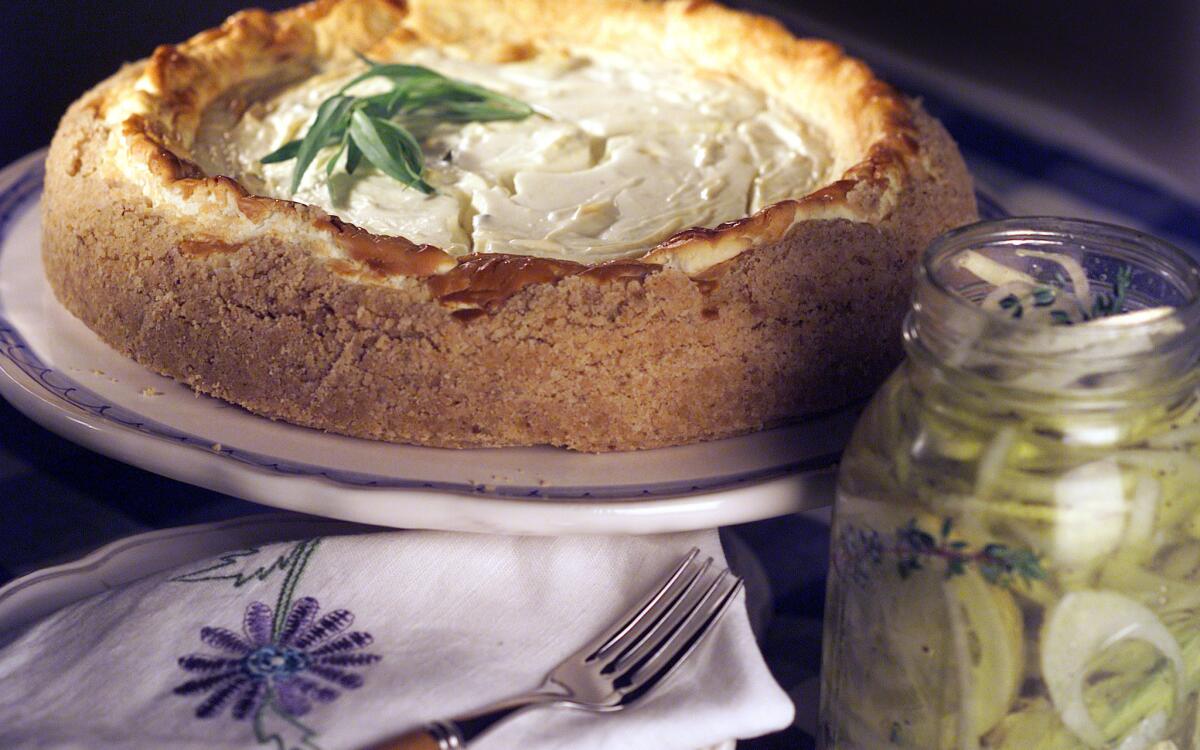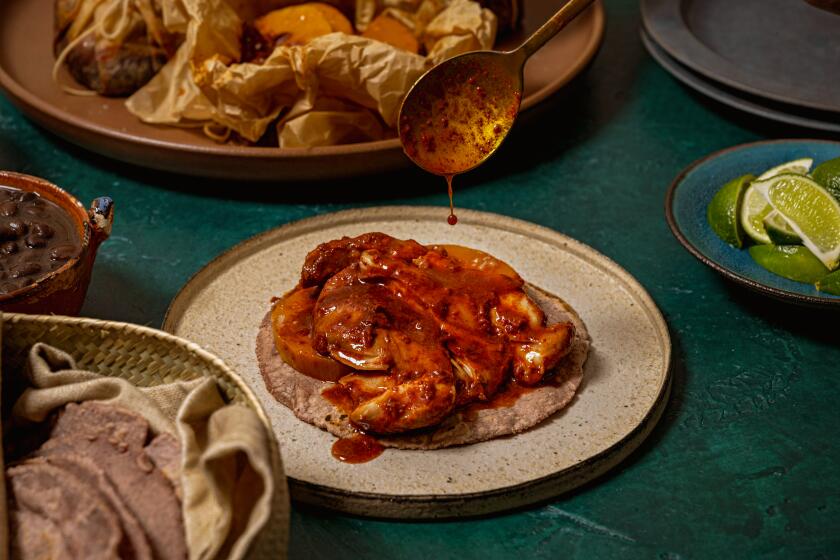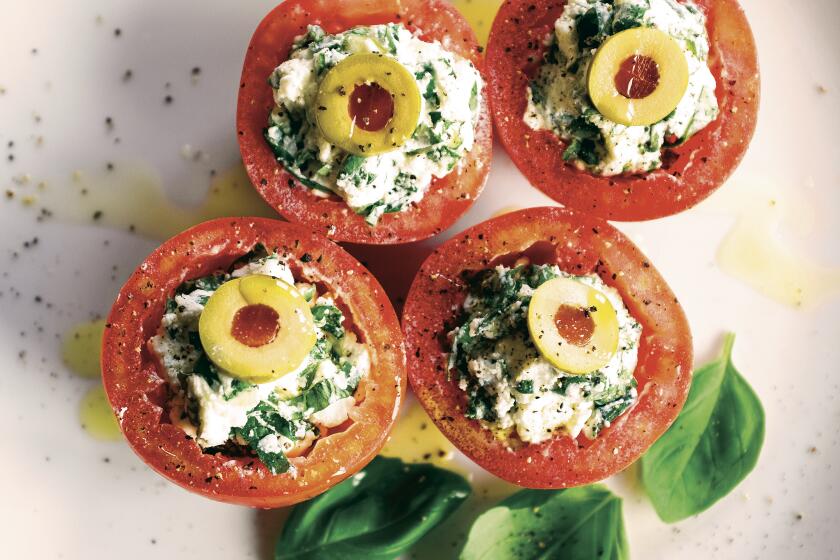Tarragon-scented goat cheese cheesecake

- Share via
There’s a lot more to the Passover holiday than just the Seder dinner. For most Israelis, preparations for the Festival of Freedom started at least a month ago.
Passover celebrates the ancient Israelites’ liberation from slavery in Egypt. Beginning at sundown on a Saturday, it has been celebrated by Jews for more than 3,000 years. The actual holiday lasts eight days, but Israelis actually start to think about it in March.
The Bible tells us that during the Passover holiday no leavened bread should be found in our homes. Even cookie crumbs are prohibited. That means a thorough spring cleaning that can start with dusting off the books and end with renovating the entire house. It’s spring, after all, and the chances of rain are getting slimmer. In fact, sales of cleaning products skyrocket to their annual peak just before Passover.
For the observant, there’s getting out of storage that other set of dishes, flatware, cookware, bake ware and utensils reserved especially for the holiday, then rinsing and switching it with its secular counterparts. But only after first carefully cleaning out and relining the cabinets. Even the car gets a royal cleaning.
Since spring has obviously sprung, an entire country is putting its winter clothes away, unpacking its warm-weather wardrobe, and suddenly realizing that every family member needs something new to wear to the Seder. Add to that the fact that it’s customary in Israel to exchange gifts on Passover, and you can imagine the preholiday sales, crowds, traffic jams and last-minute crush, especially in the supermarket.
Along side roads and in backyards, orange blossoms are open and fragrant, and in the markets it’s the season for purple-skinned garlic, fennel, melons and strawberries, black radishes and asparagus, all providing us with a far greater selection than our ancestors could have imagined.
But there’s another side of Passover I doubt those ancestors would have totally approved-the new-age Passover pasta, Passover self-raising flour, Passover wafers, cake mixes, breakfast cereals, and other Passover food clones, all made of matzo. Today, even Fido can eat kosher-for-Passover.
And I don’t imagine they would really comprehend how one people managed to divide itself on the subject of beans. Here’s how it happened:
In the beginning, there was the prohibition against possessing flour or eating leavened bread during Passover, made back then with wheat and barley. Rice, arriving in a later era, was permitted, but other grains mentioned in the Bible, like spelt, were also considered off-limits. But everybody ate beans, which mostly meant garbanzo beans, fava beans and lentils.
Some say it dates back to the Babylonian exile, others attribute it to the Middle Ages, but at some point, the Jewish people divided into two groups: Ashkenazic (living mostly in central Europe) and Sephardic (living around the Mediterranean). And when they did, they divided on the subject of beans.
The rabbis on the Ashkenazic side decided to outlaw beans on Passover. The way they figured it, merchants always recycled the same burlap bags used to store both grains and beans, and since they could get mixed with each other and lead you to sin, it was better to be safe than sorry. Ditto for rice, sesame seeds, sunflower seeds and peanuts, and anything, even oil, soap or toothpaste, made with them. The Sephardic rabbis made no such ruling.
It might never have posed a problem if the descendants of those same Sephardim and Ashkenazim didn’t have to spend Passover together in Israel today, the former ochlei kitniot (legume eaters) and the latter not. The result is confusion.
“Most of the time, hotels go according to the Ashkenazic tradition on Passover” says Haim Spiegel, corporate food and beverage manager for the Dan Hotel chain in Israel. “We don’t serve beans, and we’ll serve beef or chicken rather than lamb. If we get a large group of Sephardim, we reorganize the menu, adding lamb, beans and rice to our holiday dishes.”
Then there are manufactured food products. At major manufacturing rivals Osem and Elite, competition for the kosher for Passover trade is fierce, since sales also rise sharply during the holiday period. “A few years ago, we decided to make our chocolates kosher for ochlei kitniot on Passover,” says Ronen Zohar, marketing manager for the chocolate division of Elite. “What a mistake! We got so many complaints from Ashkenazim that we decided that we’d have to find a solution for everybody. Now there’s no problem; we even have wafer cookies made of potato flour.”
At Osem they’re always cooking up something new for Passover, like last year’s matzo-based self-rising flour, made for both Ashkenazim and Sephardim. They too have learned that while only 20% of the Jewish population is ultra-orthodox and 20% secular, a full 60% consider themselves masorati, or traditional, and for the traditional Ashkenazim, there are no beans, no seeds, no mustard, no corn oil, no regular mayo-and nothing that says ochlei kitniot.
And yet, as the younger generation grows up, the picture is changing. Even though Israeli-born Ashkenazim and Sephardim have remained polarized throughout the years, the last decade has seen a rise in intermarriage. And many Ashkenazim, such as Russian immigrants, have begun to soften their stands, even to the point of eating garbanzo bean-based hummus for the holiday. Says one salad oil manufacturer: “Their kids feel that to be Israeli is to be able to eat hummus at any time of the year.”
In a bowl, blend the matzo meal, melted butter and walnuts together with a wooden spoon. Press the mixture into the bottom and slightly up the sides of a 10-inch springform pan. Chill while preparing the filling.
Heat oven to 325 degrees. In the bowl of a food processor or using an electric mixer, blend the goat and cream cheeses together. Mix in the eggs, followed by the sour cream, salt, tarragon and pepper, beating well.
Pour the mixture into the chilled crust and place the pan on a baking sheet. Bake until the center is set, 50 to 60 minutes. Turn off the oven and let the cake remain in the oven for 30 minutes. If serving warm: Cool down to just warm, carefully remove the outer ring, slice with a knife dipped in ice water and serve, or cover with plastic wrap and chill till firm.
Get our Cooking newsletter
Get a taste of Los Angeles — and the world — with recipes and kitchen tricks from the L.A. Times’ Cooking newsletter.
You may occasionally receive promotional content from the Los Angeles Times.















